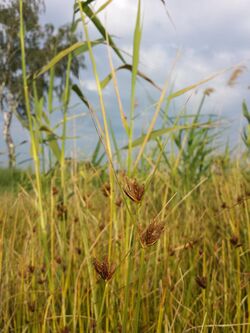Biology:Bolboschoenus planiculmis
| Flat-stem clubrush | |
|---|---|

| |
| Scientific classification | |
| Kingdom: | Plantae |
| Clade: | Tracheophytes |
| Clade: | Angiosperms |
| Clade: | Monocots |
| Clade: | Commelinids |
| Order: | Poales |
| Family: | Cyperaceae |
| Genus: | Bolboschoenus |
| Species: | B. planiculmis
|
| Binomial name | |
| Bolboschoenus planiculmis T.V.Egorova, 1967
| |
| Synonyms | |
|
Scirpus planiculmis F.Schmidt | |
Bolboschoenus planiculmis is a species of flowering plant in the sedge family Cyperaceae. It sprouts from tubers or seeds from April to May and flowers between May and July, with the aboveground biomass dying back in October. It is distributed in estuaries across and throughout East Asia, Central Asia, and Central Europe with small populations reported in Western European countries such as the Netherlands.[1][2] B. planiculmis can be identified by its bifid styles as opposed to the trifid styles which are found on all other Bolboschoenus species in Europe.[3]
Ecology
Bolboschoenus planiculmis is a perennial clonal plant with a height of 20–100 centimeters that reproduces both sexually through seeds and asexually through vegetative propagation.[4] As the fruits of B. planiculmis are floatable, it has been suggested that spreading after floods is a possible means of distribution.
Bolboschoenus planiculmis is a key wetland plant in many areas. Although it is a glycophyte, B. planiculmis was found to be more salt-tolerant than other freshwater species, as is consistent with its propagation in saline habitats, alkaline water, and mineral-rich substrates. It has also shown adaptability to agricultural management, i.e. in pastures or arable land on the sites of former saline habitats.[5] Like many Bolboschoenus species, it is commonly distributed in saline wetlands and occupies a wide variety of habitats in both coastal and inland salt marshes; it adapts easily and well to both temporarily flood terrestrial areas as well as long-term dry periods in the form of dormant underground tubers. However, as it is usually smaller than other Bolboschoenus species, i.e. Bolboschoenus laticarpus and Bolboschoenus yagara, they are suppressed by high water levels and are only found rarely in streams or ponds. The adaptability of B. planiculmis to so many climes has caused it to become a nuance species in the Czech Republic, particularly in maize fields.[6]
In Songnen Plain of northeastern China, its root tubers are a food source for the endangered Siberian crane.[7] In South Korea along the Nakdong River Estuary, B. planiculmis tubers are a major food for swan geese and other migratory waterfowl. The estuary is located in the middle of the East Asian–Australasian Flyway where more than 170,000 birds of 157 species are monitored. B. planiculmis beds in the Nakdong estuary are major overwintering habitat for these birds.[8] However, B. planiculmis is declining in East Asia due to the degradation of estuarine marshes as a result of embankments, land reclamation, and increased flooding from monsoons due to climate change. B. planiculmis is significantly affected by tidal restrictions from embankments as it grows in low elevation, and is affected by the accumulation of water in tide-restricted marshes with poor drainage during monsoon season, causing increased water depth and duration of flooding.[9]
An et al. (2021) found in observational trials that the optimum water depth for B. planiculmis growth and reproduction was 11.2–36.1 cm.[10]
References
- ↑ "Bolboschoenus planiculmis (F.Schmidt) T.V.Egorova" (in en). https://www.gbif.org/species/171736249.
- ↑ Yang, Hyunyoung; Kim, Jae Hyun; Lee, Eun Ju (1 January 2021). "Impacts of tidal restriction caused by embankments on the plastic growth responses of Bolboschoenus planiculmis in Korea" (in en). Regional Studies in Marine Science 41: 101616. doi:10.1016/j.rsma.2021.101616. ISSN 2352-4855. https://www.sciencedirect.com/science/article/pii/S2352485521000086.
- ↑ Simons, E. L. a. N.; Gonggrijp, S. (1 January 2019). "Bolboschoenus planiculmis (Cyperaceae), a third species of Bolboschoenus for the Netherlands" (in en). Gorteria Dutch Botanical Archives 41 (1): 30–34. ISSN 0017-2294. https://natuurtijdschriften.nl/pub/689310/.
- ↑ An, Yu; Gao, Yang; Tong, Shouzheng (1 August 2018). "Emergence and growth performance of Bolboschoenus planiculmis varied in response to water level and soil planting depth: Implications for wetland restoration using tuber transplantation" (in en). Aquatic Botany 148: 10–14. doi:10.1016/j.aquabot.2018.04.005. ISSN 0304-3770. https://www.sciencedirect.com/science/article/abs/pii/S0304377017303807.
- ↑ Hroudová, Zdenka; Zákravský, Petr; Flegrová, Monika (1 January 2014). "The tolerance to salinity and nutrient supply in four European Bolboschoenus species (B. maritimus, B. laticarpus, B. planiculmis and B. yagara) affects their vulnerability or expansiveness" (in en). Aquatic Botany 112: 66–75. doi:10.1016/j.aquabot.2013.07.012. ISSN 0304-3770. https://www.sciencedirect.com/science/article/abs/pii/S0304377013001290.
- ↑ Hroudová, Zdenka; Zákravský, Petr; Ducháček, Michal; Marhold, Karol (2007). "Taxonomy, distribution and ecology of Bolboschoenus in Europe". Annales Botanici Fennici 44 (2): 81–102. ISSN 0003-3847. https://www.jstor.org/stable/23727599.
- ↑ An, Yu; Gao, Yang; Tong, Shouzheng; Liu, Bo (5 March 2021). "Morphological and Physiological Traits Related to the Response and Adaption of Bolboschoenus planiculmis Seedlings Grown Under Salt-Alkaline Stress Conditions". Frontiers in Plant Science 12: 567782. doi:10.3389/fpls.2021.567782. ISSN 1664-462X. PMID 33746992.
- ↑ Kim, Gu-Yeon; Kim, Ji Yoon; Ganf, George G.; Lee, Chan-Woo; Joo, Gea-Jae (1 May 2013). "Impact of over-wintering waterfowl on tuberous bulrush (Bolboschoenus planiculmis) in tidal flats" (in en). Aquatic Botany 107: 17–22. doi:10.1016/j.aquabot.2013.01.004. ISSN 0304-3770. https://www.sciencedirect.com/science/article/abs/pii/S030437701300017X.
- ↑ Yang, Hyunyoung; Kim, Jae Hyun; Lee, Eun Ju (1 January 2021). "Impacts of tidal restriction caused by embankments on the plastic growth responses of Bolboschoenus planiculmis in Korea" (in en). Regional Studies in Marine Science 41: 101616. doi:10.1016/j.rsma.2021.101616. ISSN 2352-4855. https://www.sciencedirect.com/science/article/pii/S2352485521000086.
- ↑ An, Yu; Song, Tiejun; Zhang, Yang; Tong, Shouzheng; Liu, Bo (2021-10-04). "Optimum water depth for restoration of Bolboschoenus planiculmis in wetlands in semi-arid regions" (in en). Hydrobiologia 849: 13–28. doi:10.1007/s10750-021-04704-9. ISSN 1573-5117. https://doi.org/10.1007/s10750-021-04704-9.
Wikidata ☰ Q12027920 entry
 |

